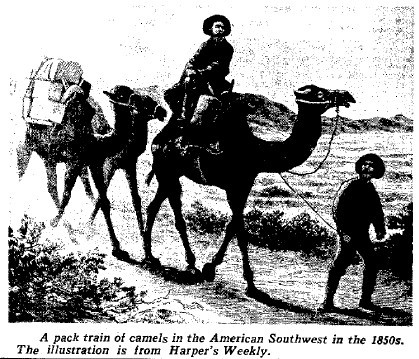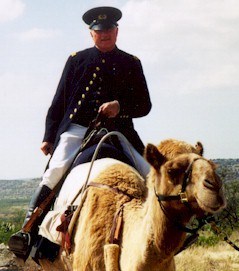The 1st US Camel Corps, 1856.The use of camels for warfare has gone back for thousands of years as t
The 1st US Camel Corps, 1856.The use of camels for warfare has gone back for thousands of years as the camel has many advantages over the traditional horse. In dry arid deserts a camel can function for up to a week without water and can cross desert terrain to rough for horses. While not as fast or maneuverable as a horse, a camel is a much larger animal which lends to an intimidation factor in battle. These were the same arguments made by Capt. George H. Crossman, a Mexican American War veteran who was accustomed to operating and fighting in dry desert conditions. Throughout the 1850’s Capt. Crossman preached to all who would listen, espousing the view that the US Army should adopt camels for use on the western frontier.In 1855 he got his chance when Secretary of War Jefferson Davis approved his plan to assemble an experimental camel corps. With $30,000 dollars Capt. Crossman and his associate Major Henry C. Wayne purchased 76 camels from Greece, Malta, Turkey, and Egypt along with 5 experienced Bedouin handlers.In 1856 the camels landed at Indianola, Texas and were driven Camp Verde for assignments. Once there the men were trained by the camel handlers how to ride, care for, and command their camels. From 1856 to 1860 the 1st US Camel Corps patrolled the southwest. The Camel Corps even conducted exploratory surveys and mapping expeditions Arizona, New Mexico, Colorado, and California. Early results of the experiment showed great success, as the animals easily operated in the deserts of the southwest. Furthermore the camels proved that they could cross rugged terrain that horses could not go. If it wasn’t for the American Civil War, John Wayne and the Lone Ranger may have ridden camels instead of horses.In 1860, with tensions rising between the north and the south, the US Army began to consider a war fought in the east. Regular cavalry was given priority over experimental camelry and in 1861 the US Camel Corps was disbanded. Some were sold to the public, most were turned loose into the wild. As a result the southwest actually sported a small population of wild camels. The last camel sighting occurred in 1941 near Douglas, Texas. -- source link
Tumblr Blog : peashooter85.tumblr.com
#history#cavalry#animals#camels#southwest#us army#war#military



